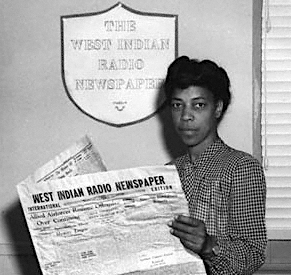OTD in early British television: 29 June 1939

John Wyver writes: The magazine show Picture Page was the widely recognised ‘hit’ of the pre-war Television service from Alexandra Palace. By the summer of 1939 it was mounted twice on Thursdays, in the afternoon and evening, with often little or no repeat of guests between the two transmissions. Which was the case on Thursday 29 June 1939, when the line-ups were typically eclectic.
The show was linked by Joan Miller at a putative telephone switchboard, and each guest was rigorously rehearsed in advance for their two- or three-minute spot with interviewer Leslie Mitchell. In the afternoon the job of ‘handling’ Indian economist and educator Malcolm Adeseshiah, Travelling Secretary at the Student Movement House, was entrusted to the Jamaican writer and activist Una Marson, who worked on occasions with the programme through 1939.
After achieving success as a poet and playwright in Jamaica, Marson first came to London in 1932, where as her detailed Wikipedia entry notes
The racism and sexism she found in the UK “transformed both her life and her poetry”: the voice in her poetry became more focused on the identity of black women in England. In this period, Marson not only continued to write about women’s roles in society, but also put into the mix the issues faced by black people who lived in England.
She lived again in Jamaica between 1936 and 1938, after which she returned to London, working as a journalist and for Picture Page. Then during the war, in 1941, she was hired by the BBC Empire Service, becoming producer of the show Calling the West Indies, which she transformed into the hugely influential Caribbean Voices.
The eclecticism of Picture Page is demonstrated by the inclusion on that June afternoon alongside Adeseshiah of ‘strong girl’ Jose Terina, who tore a telephone directory in half; Australian actor Harry Atkinson, who had come to Britain in 1891; Una Wyte, who contributed two songs; and Mary Oliver, who with her partner Heather Jenner had just started a marraige bureau in Bond Street. All in 23 minutes.
Incidentally, Mary Oliver and Heather Jenner can be in this delightful British Pathé newsreel from 1939.
The evening broadcast, which was the 256th edition (like printed magazines, each one was numbered), ran over twice as long, at 51 minutes, and featured four members of crews taking part in a royal regatta at Henley; Lt-Col. Sir Stewart Symes, D.S.O., retiring Governor-General of the Sudan, and who was later recognised as a comparatively progressive colonial official; film star Margaret Lockwood; and newly appointed Master of the Armouries at the Tower of London, James Mann.
The Mackinnon of Mackinnon, England’s oldest Test Match player (he played a single match on the 1878-79 tour of Australia), was interviewed along with the captains of the Oxford and Cambridge cricket teams, who were to meet at Lord’s in the coming days. Sophie Harris, one of the three partners in the collaborative design team ‘Motley’, was interviewed about her work. And Indian Yogi Vithaldas Parikh demonstrated a few of his simpler exercises.
Viennese café theatre proprietor (and refugee from the Nazis)( Hugo F. Koenigsgarten was on next, followed by Chief Os-Ke-Non-Ton, Canadian singer and Chief of the Mohawk Nation, who was about to sail to Sydney to perform there in Samuel Coleridge-Taylor’s Hiawatha. And finally Minnesota Senator Ernest Lundeen came on screen to talk about travelling in the Pan-American flying boat ‘Yankee Clipper’, which had just made the first transatlantic passenger flight from New York (and which crashed killing 24 people in Portugal in 1943).
Hard to imagine The One Show offering quite such a broad range of guests today.
[OTD post no. 194; part of a long-running series leading up to the publication of my book Magic Rays of Light: The Early Years of Television in Britain in January 2026.]
Leave a Reply